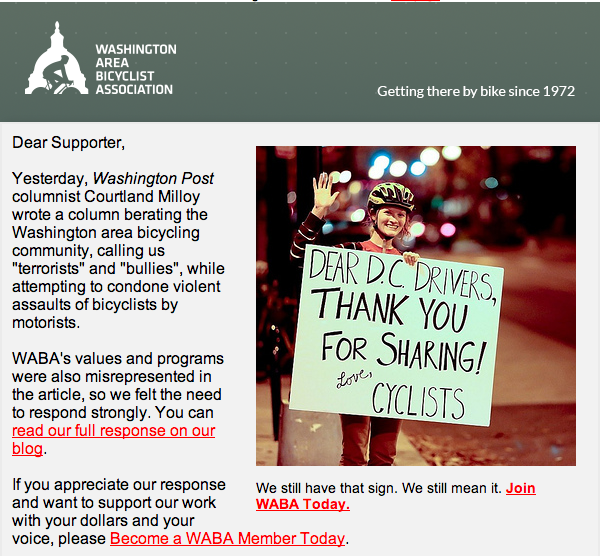If you follow news about bicycling and urban transportation in the United States, by now you've probably seen Courtland Milloy's rant against DC bicyclists in the Washington Post. Milloy used his column to call people on bikes "bullies," comes scarily close to condoning striking bicyclists with a car, and maligns the work of the Washington Area Bicyclist Association, our biggest members in the DC metro area.
What's a local advocacy organization to do?
When you're faced with an unexpected moment like a high profile shot against your mission and organization, only two words matter: rapid response.
WABA provides a strong example of how to harness a "crisis-tunity" like the Post article. Thanks to quick thinking at the leadership and staff level, WABA responded elegantly and quickly to publicly address the controversy that Milloy's article stirred up – and channel their supporters' outrage into awareness about WABA's advocacy.
1. The blog post
First, executive director Shane Farthing penned a well-reasoned, fact-based blog post that directly addressed the article. Here's why I think Shane's response was spot-on:
- It speaks to WABA's base. Shane doesn't beat around the bush: he calls out Milloy's article for being "violent," "irresponsible," and "incorrect." Shane knows that people who ride bikes in DC are angry, and he meets them right where his supporters (and potential supporters) are at this moment. He also asserts that his organization will continue to "unapologetically" advocate for bike infrastructure – a statement that will make supporters cheer.
- It highlights the facts. Shane speaks clearly to WABA's priorities and work, past and present. He uses his response as a chance to set the record straight from his organization's perspective.
- It lets journalists handle the point-by-point rebuttal. Shane chose to focus on addressing the relevance, history, and value of his own organization's work. He lets other outlets – like Washington City Paper, WashCycle, and even the Washington Post – debate Milloy on his own logic. This story was sufficiently high-profile that plenty of bloggers and journos were up to the task.
- It was timely. Shane didn't waste time in responding. By the time WABA tweeted and Facebooked links to the blog post, about 12 hours after Milloy's article was posted online, they were just in time to be relevant in today's heated online conversation. Sure enough, WABA's advocacy coordinator, Greg Billing, tells me that Shane fielded six or seven interviews today.
My only suggestion would be to also include a clear call to action in the post, so that people who agree with WABA have an outlet for their frustration other than angrily tweeting and Facebooking. Traffic to the blog post could have been an opportunity to gin up donations from existing and new supporters.
2. The emails
Second, WABA sent out two emails about the article – one to its members and one to non-members – this afternoon. Here's what I love about these messages:
- They're clear responses to the Milloy article. Supporters are more likely to open an email and take action if a message is relevant at the moment. The subject line for both emails was "We are not bullies," a clear reference to the title of Milloy's piece. A photo in the email depicted a handmade sign that Milloy referenced.
- The emails were targeted based on engagement level. Non-members were served one ask; members got another.
- WABA used the opportunity make calls to action. The email to non-members included a clear membership ask, and existing members were served an attractive "DONATE NOW" button.
- They were timely. Again, these emails were sent on the day of the controversy about Milloy's article – not one day or one week later. WABA arrived in supporters' inboxes when the conversation was at its loudest.

A screenshot of the email that WABA sent to non-members today. Source: WABA
Of course, data will tell the real story about these emails' successes. I hope that these two little messages bring WABA many new dollars and new members. After all, nothing boosts membership and dollars like a fight.
Advice for other advocates
I asked Greg Billing, WABA's Advocacy Coordinator, whether he has any rapid response advice for other organizations. He did.
"This is an opportunity for your organization to stake a claim in the dialogue," said Greg. "You never know when an unexpected developments like this will come along, so be ready for them. Our team has gone through this enough that we know who does what and what needs to happen."
Large issue advocacy organizations often have entire communications plans dedicated to rapid response situations. Even if your organization isn't able to dedicate time or resources for a comprehensive plan, it pays to be prepared with clarity around roles.
One good way to prepare is to think about your group's key mission and goals.
"Always think about how you make the bigger case of what you're doing as an organization," said Greg. "It's also good to know how you defend your work if you're in a position to have to do so."
Learn more from Greg and other advocates about how your organization can respond quickly to unexpected moments, both bad and good – join our webinar later this year on rapid response for state and local biking and walking advocacy organizations.

